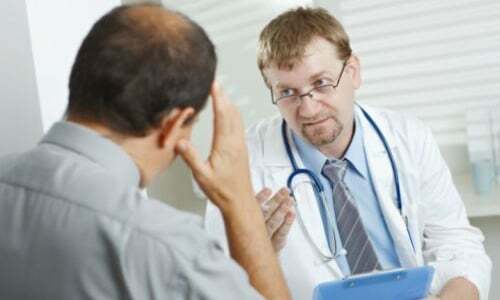Among all sexually transmitted infections and affecting the genitourinary system, the most common is chlamydial prostatitis. The cause of the disease is urogenital chlamydia, which, according to the latest statistics, affects about 30% of all male population of the country( young and adult) every year. In the absence of timely and effective treatment, the disease not only leads to serious complications, contributing to the emergence and development of new ones, but also turns into a chronic form, provoking chronic prostatitis.

Factors for the development of chlamydial prostatitis
The causative agent of urogenital chlamydia is the gram-negative chlamydia bacterium( Chlamidia trachomatis), which causes sexually transmitted diseases, perinatal infection and a number of others. The incubation period is from 5 days to a month. Getting into the human body, the infection may not appear for a certain time, subsequently causing uncontrolled infection of sexual partners. The latent form of infection is considered no less dangerous than the manifest one, since the patient does not suspect that he is infected and does not consult a doctor, which delays treatment and entails certain complications.
Chlamydia are transmitted only through sexual contact. At the very beginning of infection, the patient does not experience any inconveniences or alarming symptoms, except for frequent urge to urinate. However, this symptom is not threatening and does not cause the patient any discomfort, which is the reason for the untimely referral to the urologist. Gradually and thoroughly affecting the mucous membrane of the urethra, chlamydia contribute to the development of inflammatory processes and various diseases, among which a large percentage of chlamydial prostatitis.
Clinical picture with chlamydial prostatitis
Chlamydia is not a representative of normal microflora of any person( men and women).Its detection in the smear testifies to the course of the infectious process. In the absence of clinical symptoms of the disease, specialists allow a temporary balance between infection and the patient in conditions that restrict the reproduction of the microorganism, but do not interfere with it. When these conditions are eliminated, the balance becomes invalid, allowing the infection to actively multiply.
In some cases, this disease can be asymptomatic, without manifesting or disturbing a person. Infection can be detected quite by accident, by examining and passing the analysis. Over time, when there is active growth and multiplication of the infection, the disease begins to progress, acutely manifest and cause some symptoms. In neglected cases, when the disease takes a chronic form( meaning chronic chlamydial prostatitis), the patient may be concerned:
- with periodic aching pains in the rectum, sacrum, in the groin, scrotum;
- secretions from the genitourinary system both during defecation and when urinating;
- by rapid, difficult and painful urination;
- with a constant feeling of incomplete emptying of the bladder;
- itching in the urethra and anus;
- is sufficiently weak erection or its absolute absence;
- with turbidity of urine, with an admixture of mucous and purulent flakes and secretions in it;
- rapid ejaculation or loss of orgasm;
- with a small body temperature reaching 37 degrees;
- slight intoxication, as a result of the infectious process occurring in the body;
- with severe stress;
- with insomnia;
- headaches;
- with a breakdown;
- heart palpitations;
- other mental disorders.
The symptoms listed above may be single or complex. When one of the symptoms manifests, the patient associates his condition with the development of other diseases, without suspecting the chlamydial prostatitis. Only when the symptoms are complex, the patient is forced to turn to the appropriate specialist - the urologist.
What should I look for?
With chlamydial prostatitis, special attention is paid to the nature of chlamydial lesion of the prostate, which is caused by three main forms of the disease:
- catarrhal;

- follicular;
- is parenchymal.
The catarrhal form of chlamydial prostatitis is characterized by soreness of the prostate gland, which is felt during palpation through the rectum directly. An increase in the prostate gland is not observed. If at this stage there is no treatment, the catarrhal prostatitis passes into the follicular. When palpation, the prostate gland remains unchanged in size. Instead, the doctor determines and observes dense and sensitive nodules of various sizes. In the parenchymal form of chlamydial prostatitis, the prostate gland is enlarged and painful, and a changed configuration and consistency is observed.
Complications of chlamydial prostatitis
The asymptomatic nature of chlamydial prostatitis leads to various complications, among which specialists pay special attention to infertility, impotence, decreased immunity, narrowing the urethra and sperm-excreting tracts, the death of cells responsible for the production of the hormone testosterone. When infertility against the background of the chronic form of chlamydial prostatitis, the glandular tissue of the prostate glands, the narrowing of the prostate ducts, the amount and quality of the prostate secretion changes. The result of all this is immobilization and rapid death of spermatozoa.

Diagnosis with chlamydial prostatitis
Chlamydial prostatitis, like all other infectious diseases, must be carefully diagnosed in order to identify the main factor and make an accurate diagnosis. Diagnosis involves conducting a study of the secretion of the prostate gland with further detection of chlamydiae in it. In addition to the patient's complaints and his general condition, the doctor conducts a thorough examination, which is characterized by:
- with a mandatory smear from the urethra;
- analysis of the ejaculate for the presence of infection;
- revealing conditionally pathogenic bacterial flora;
- immunological, genetic and ultrasound studies.
Specialists in the field of urology in the diagnosis and treatment of chlamydial prostatitis note that the disease can be caused not only by chlamydia, but also by a combination of other infections. That is, a combination of chlamydia, gonococcus, mycoplasma, trichomonads and other bacteria. Therefore, the accuracy of diagnosis of the cause of the disease is particularly important in order to avoid recurrence of the disease and to select appropriate treatment, given the sensitivity of all infections to a particular drug.
Control of chlamydial prostatitis
Chlamydial prostatitis requires mandatory medical intervention to destroy the underlying disease factor. The disease is difficult to treat, especially at later stages of its development. This picture is due to the fact that chlamydia cells practically do not react to some drugs. However, this does not exclude the possibility and necessity of treating chlamydial prostatitis. The treatment itself is complex and involves carrying out both antibiotic therapy and other types of medical measures aimed at the destruction of the underlying infection and the complete restoration of the functions of the prostate gland.
When choosing a treatment regimen, the following points are taken into account:
- degree and severity of chlamydial prostatitis;
- individual characteristics of the patient's body;
- presence of other infections and bacteria in the smear.
The basis of treatment is antibacterial therapy, based on the use of anti-chlamydial antibiotics, strictly prescribed and controlled by the attending physician. Since drugs with a wide spectrum of action are prescribed, it is considered that they have a harmful effect not only on chlamydia and other infections, but also on various organs( such as the liver, kidneys, stomach, heart).Any patient should take this fact into consideration and not engage in self-medication, independently selecting a complex of antibiotics.
The reception of antibiotics for a long time is fraught with a violation of the intestinal microflora and the development of dysbiosis. Therefore, after treatment, other drugs are prescribed, which are directed to the restoration of microflora. Since persistent chlamydia often develop resistance to certain types of antibiotics, treatment is unsuccessful and does not give positive results. In this case, resort to the method of lymphotropic antibiotic therapy, based on the harmful effects on chlamydia.
In addition to antibiotics and lymphotropic therapy, the pathogenetic method is used, which helps to eliminate congestion and stagnant phenomena in the pelvic organs, as well as stimulation of lympho- and blood circulation, restoration of prostatic function. In parallel, laser radiation is prescribed, which has an anti-inflammatory effect, restores immunity and improves blood circulation. One of the important methods of fighting chlamydial prostatitis is prostate massage. The result of therapeutic massage of the prostate is the patient getting rid of stasis of secretion, improving the susceptibility of prostate tissues to the antibiotics used, and stimulating metabolic processes.
To achieve the full therapeutic effect, it is recommended to pay attention to:
- active motor mode - to move more and perform special physical exercises aimed at reducing the pelvic floor muscles and normalizing the stool;
- proper nutrition - avoid salty, sharp, bitter, spicy dishes, as well as alcoholic, alcoholic and carbonated drinks;
- treatment procedures - use mud therapy, resort factors and others.
As the disease affects the nervous and immune system of a person, a physician selects and assigns a set of such drugs that maximally restore immunity and strengthen the body, and also have a sedative effect, eliminating the symptoms of stress, nervous breakdown and depression. During treatment it is recommended to refrain from active sexual life with the purpose of complete restoration of the functions of the prostate gland.



